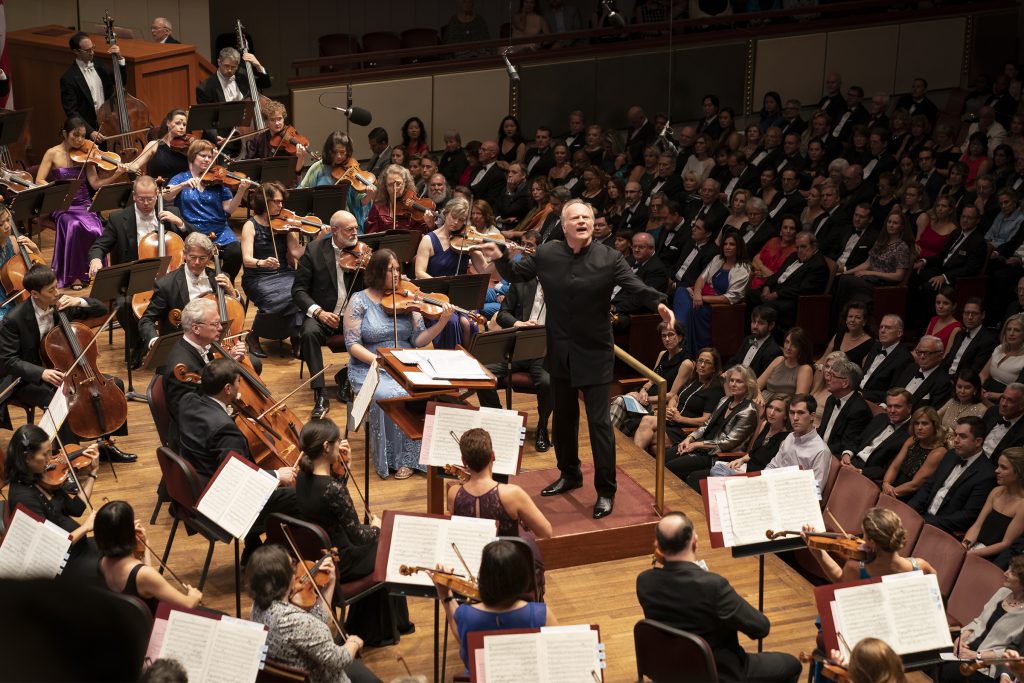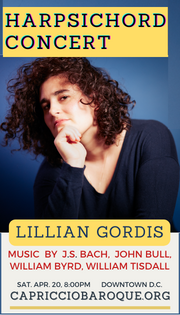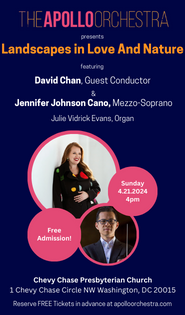With his contract extended, Noseda, NSO achieve liftoff in heavenly gala opener

Gianandrea Noseda conducted the National Symphony Orchestra in its season-opening gala concert Saturday night at the Kennedy Center. Photo: Scott Suchman
The star of Gianandrea Noseda will now shine over Washington through 2025.
The National Symphony Orchestra has extended the existing contract of its Italian music director four more years. The announcement came midway through the NSO’s season-opening gala concert in the Kennedy Center Concert Hall on Saturday night. Underscoring the good cheer all around was a new record in NSO gala fundraising of $2 million, plus another $10 million in special funding in support of new artistic initiatives.
Many things are improving at the NSO under Noseda, not least the quality of programming for gala and holiday concerts. Out with the pops and crossover gala concerts of recent years, and in with more serious repertoire. The theme this year and throughout the upcoming season is space, chosen to honor the 60th anniversary of NASA and the 50th anniversary of that agency’s first landing on the moon, coming up next summer. Spacesuits were even on display in the lobby. (The video broadcast of the concert can be seen at Medici.tv.)
The first four movements of Gustav Holst’s astrological suite The Planets served as the main courses of this relatively brief program without intermission. This music is not so much about the planets as object of space exploration but about their supposed influence on human emotions. Holst even ordered the movements according to the order of the zodiac signs over which the planets rule.
Holst’s vast orchestration provided Noseda a chance to show off the orchestra’s regular members and beyond with extended woodwind and brass sections, plus two timpanists, two harpists, and organist. The massed forces made the opening of “Mars” a martial thrill, with a particularly swift tempo imposed by Noseda (after the traditional performance of The Star-Spangled Banner to open the season). Amid the full blare of the amped-up brass section, with Holst turning up the volume to fffff at the conclusion of the movement, the player of the conspicuous tenor tuba (euphonium) part excelled.
The moon made a soft appearance in Debussy’s magical prelude Clair de lune, as orchestrated by Leopold Stokowski. Diaphanous melodic snippets shared among soft woodwinds and lush strings undulated to the accompaniment of harp and vibraphone twinkles.
As the evening’s superstar soloist, violinist Joshua Bell served up four palate-cleansing bonbons, beginning with the “Song to the Moon” aria from Dvořák’s opera Rusalka. Although Noseda shaped the orchestra into a near-whisper of sound, Bell and the orchestra were not quite on the same page in the double-stop section and in unisons with the violins and flutes. The problem was resolved in the saccharine “Estrellita,” a popular song by Mexican composer Manuel Ponce, adapted for violin by Jascha Heifetz as pure schmaltz with lush strings.
Later Bell poured on the charm in two technical showpieces by the Spanish violin virtuoso Pablo de Sarasate: the “Habanera” from his Carmen Fantasy and the Zigeunerweisen, both featuring music inspired by the Roma people, known for their skills at astrology. Bell did not disappoint, unpredictably rushing ahead of the orchestra especially in the less effective first piece but wowing consistently with technical finesse in both works.
The evening belonged, however, to the NSO, which showed mettle and sensitivity in the other movements of the Holst suite. Principal horn player Abel Pereira and concertmaster Nurit Bar-Josef serenaded one another in solos across the exquisite fabric of soft woodwinds and strings in the amorous “Venus.” All the musicians scurried skillfully through the feather-light “Mercury” movement, a tour-de-force of instrumental volatility, and Noseda’s infectious buoyancy lifted up “Jupiter,” the stately hymn tune of the middle section surrounded by jovial fast sections.
Film music made an appearance with Voyage, a new orchestral piece by Michael Giacchino, composers of scores for Star Trek, Star Wars: Rogue One, premiered by the NSO in June. Dull melodies presented in trombone and flute paled next to Holst, although the final crescendo boomed impressively over the organ pedal. The NSO is embracing the trend of performing live scores for film screenings, with a whole series of Star Wars screenings this season.
Noseda, as tall as Darth Vader and dressed all in black, offered a fitting encore–John Williams’ “Imperial March” from Star Wars: The Empire Strikes Back, with a knowing wink.
Gianandrea Noseda conducts the NSO in Rachmaninoff’s Isle of the Dead, Respighi’s Trittico botticelliano, and Mussorgsky’s Pictures at an Exhibition 7 p.m. September 27 and 8 p.m. September 28 and 29. kennedy-center.org; 202-467-4600







Posted Sep 25, 2018 at 12:14 pm by Nancy Shear
Yes, Stokowski’s Debussy transcription is ethereal and beautiful. But he also did superb transcriptions of “The Star- Spangled Banner” and Mussorgsky’s “Pictures at an Exhibition” (Stokowski’s “Pictures” is more Russian in feeling than Ravel’s French-tinted one).